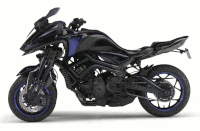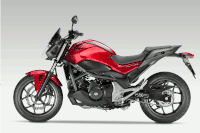The world's motorcycle manufacturers are fighting on an ever-shifting battlefield as the fickle tastes of consumers flit from one fad to another. The task of predicting the next big sales opportunities and racing to catch rivals who are already capitalising on them is a mammoth one.
So when the world's two leading motorcycle companies both turn in the same direction and focus on a completely new market, it's worth taking note. And that's what's happening now, as both Honda and Yamaha accelerate development of leaning three-wheeled bikes that use technologies previously only seen on scooters and implement them on much bigger, faster models.
Both firms are developing reverse trikes, with two front wheels and the rear end of a conventional bike, that lean into corners to give a riding experience that's as close as possible to a two-wheeled machine while adding a new layer of grip and stability. We've already seen that such designs can be a hit in the scooter market, where Piaggio's MP3 and its derivatives have been around for more than a decade, and Yamaha is also finding success with the similar Tricity. But so far there's been resistance to applying the same thinking to larger, faster bikes.
Yamaha MWT-9 production bike
Yamaha has been the most openly receptive to the three-wheeled idea. Its MWT-9 concept trike, revealed in 2015, took the engine and rear end from the FZ-09 (MT-09 on international markets) and combined it with a new tubular frame and a Tricity-style two-wheeled front end. Since then, a host of patents have emerged to suggest that it’s much more than just an eye-catching show bike, and is very likely to reach production.
Just last month a new batch of publications revealed images that appear to show a more productionised version of the MWT-9. One is a faired version, looking much like the concept but with small tweaks to the body panels that simplify their construction. Changes include separate side panels connecting the tank to the nose rather than the large one-piece design of the concept. Some of the patents (eg application US2017/088222) relate specifically to the bodywork, and particularly to small panels that mount to the tilting suspension parts to cover their mechanical elements.
A second Yamaha patent application (US2017/088223) relates specifically to an unfaired version of the same bike. Pictures in it reveal larger suspension-covering panels and a different front section to the tank, as well as a standalone headlight unit. Unlike the faired version, which has been previewed as the MWT-9 concept, the naked one has never been seen before.
Both bikes share the normal FZ-09’s 850cc triple, even using the stock two-wheeler’s swingarm. Japanese sources have long said that the MWT-9 will become a production model, and the mounting evidence suggests they’re right.
Honda’s three-wheeled plans
Like Yamaha, Honda has shown a leaning three-wheeled concept bike, the NeoWing, which combined elements of Goldwing with a tilting two-wheeled front and a futuristic hybrid engine.While there’s some suggestions that the next-generation ‘Wing will be offered in three-wheeled form as well as in conventional two-wheeled guise, Honda also has an ongoing trike project based around the NC750.
The firm has so far patented three separate leaning front suspension systems, all shown attached to modified NC750 rear ends. It’s more than likely Honda has built prototypes using each of the different designs.
The design to be most recently patented is also the simplest. Like the Yamaha MWT-9, Tricity and the Piaggio MP3, it gets its leaning ability from a pair of parallel links running across the front. These pivot at their centers at the top and bottom of what would be the steering head, and carry their own head tubes at each end, again on pivots.
Simple vertical struts hold each front wheel, with a short leading-link and coilover on each side providing the suspension. The system is very close to the Piaggio MP3’s design, and rather simpler than the Yamaha set-up, which uses four telescopic fork legs, two for each wheel.
Earlier Honda patents included a similar one, but with trailing links for the suspension, and a completely different arrangement with front swingarms instead of the transverse parallelogram tilting system. The NeoWing uses yet another design, with car-style wishbone suspension.
Why three wheels?
The market for leaning three-wheelers might be unproven, but in recent years sales of conventional trikes have grown enough to get Harley Davidson to launch its own range.One reason is that there’s a growing generation of older riders who don’t want to give up their bikes even when manhandling them becomes difficult. Add to that an increasingly safety-conscious society and the pressures that many riders feel from loved ones to curb risks, and it’s becomes clear that there’s a market out there for something that provides a bike-style riding experience but with fewer potential pitfalls.
Anyone who’s tried a Piaggio MP3 or Yamaha Tricity will be familiar with how easy it is to forget their three-wheeled weirdness once on the move, so there’s reason to believe these machines will feel much like normal bikes in day-to-day use. But with twice the front-end contact patch and the ability to hold themselves upright at a standstill, there’s a safety net that you won’t find on a two-wheeler.
Moreover, in some markets there may be scope for car drivers to jump straight onto a leaning three-wheeler without jumping through hoops to get an additional motorcycle entitlement. That could provide access to a massive, untapped market of casual potential motorcyclists.










/cloudfront-us-east-1.images.arcpublishing.com/octane/CUCCR6OUUEJABFLWUFLFYAV7KU.jpg)



/cloudfront-us-east-1.images.arcpublishing.com/octane/2WF3SCE3NFBQXLDNJM7KMXA45E.jpg)
/cloudfront-us-east-1.images.arcpublishing.com/octane/G4MG6OUCJNBSHIS2MVVOTPX65E.jpg)
/cloudfront-us-east-1.images.arcpublishing.com/octane/IIGGWFOTOJGB7DB6DGBXCCMTDY.jpg)
/cloudfront-us-east-1.images.arcpublishing.com/octane/QSTCM6AVEZA5JJBUXNIQ3DSOF4.jpg)
/cloudfront-us-east-1.images.arcpublishing.com/octane/U4I7G625B5DMLF2DVIJDFZVV6M.jpg)
/cloudfront-us-east-1.images.arcpublishing.com/octane/B6XD6LS6IVCQPIU6HXDJSM3FHY.jpg)
/cloudfront-us-east-1.images.arcpublishing.com/octane/ICL63FEDDRDTTMINYICCEYGMDA.jpg)
/cloudfront-us-east-1.images.arcpublishing.com/octane/FCGZHQXRBZFLBAPC5SDIQLVF4I.jpg)
/cloudfront-us-east-1.images.arcpublishing.com/octane/WNOB6LDOIFFHJKPSVIWDYUGOPM.jpg)

/cloudfront-us-east-1.images.arcpublishing.com/octane/X33NU3E525ECRHXLNUJN2FTRKI.jpg)
/cloudfront-us-east-1.images.arcpublishing.com/octane/6KKT5NNL2JAVBOXMZYS5ZO76YA.jpg)
/cloudfront-us-east-1.images.arcpublishing.com/octane/J5RKG5O455GMPGQRF2OG6LRT7A.jpg)
/cloudfront-us-east-1.images.arcpublishing.com/octane/GX2CIZKQVRH2TATDM26KFG2DAE.jpg)
/cloudfront-us-east-1.images.arcpublishing.com/octane/ZWIDYSAKQZHD5BHREMQILXJCGM.jpg)
/cloudfront-us-east-1.images.arcpublishing.com/octane/CYUHJZCTSJCH3MRAQEIKXK7SCQ.jpg)
/cloudfront-us-east-1.images.arcpublishing.com/octane/LKOFINY56FCXJCANJ5M7ZDQUBY.jpg)
/cloudfront-us-east-1.images.arcpublishing.com/octane/4NBPDACMWJH63JQYJVK3QRBDZI.jpg)
/cloudfront-us-east-1.images.arcpublishing.com/octane/KKHQHRR3FJGX7H2IPU6RALMWG4.jpg)

/cloudfront-us-east-1.images.arcpublishing.com/octane/5IOFS5JAE5FOXMNA23ZRAVVYUU.jpg)
/cloudfront-us-east-1.images.arcpublishing.com/octane/CGXQ3O2VVJF7PGTYR3QICTLDLM.jpg)

/cloudfront-us-east-1.images.arcpublishing.com/octane/OQVCJOABCFC5NBEF2KIGRCV3XA.jpg)